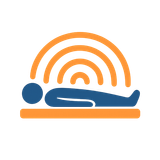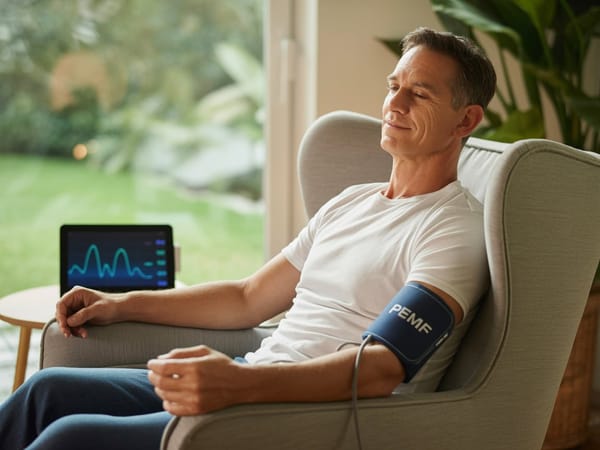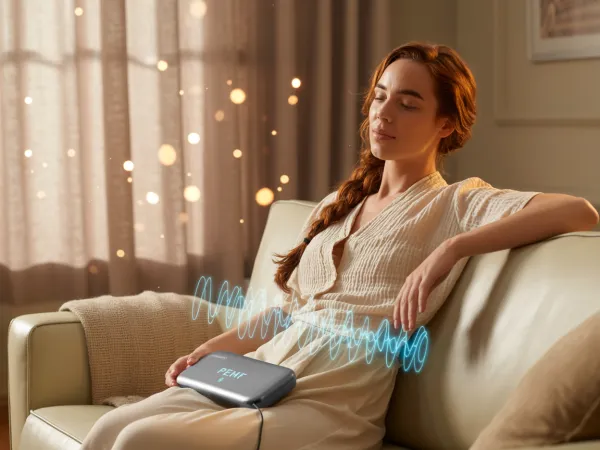What is the Best PEMF Frequency for Sleep?
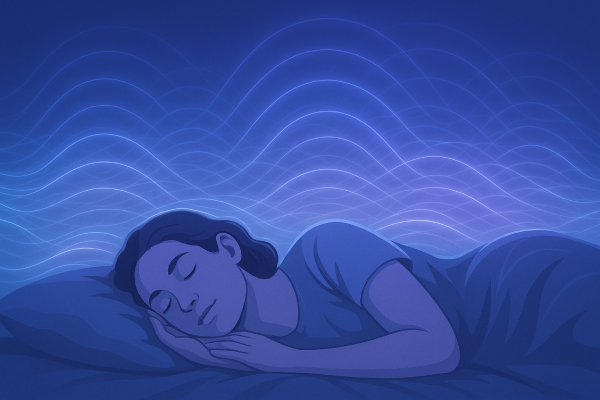
Why is Everyone Talking About PEMF for Sleep?
Did you know that over 70 million Americans suffer from chronic sleep problems? It is a staggering statistic that highlights a silent epidemic. For decades, the primary solutions have been pharmaceuticals, which often come with unwanted side effects and the risk of dependency. However, a non-invasive and drug-free technology is rapidly gaining recognition for its remarkable ability to improve sleep.
This technology is Pulsed Electromagnetic Field (PEMF) therapy. As of 2025, a growing body of scientific evidence supports its use, making it one of the most exciting wellness trends. This guide will explore the science behind the best PEMF frequency for sleep.
What You'll Learn in This Guide:
- Optimal PEMF frequencies for different sleep disorders
- Latest 2025 clinical trial results and expert recommendations
- How to choose and use PEMF devices effectively
- Safety protocols and contraindications
- Proven protocols for maximum sleep improvement
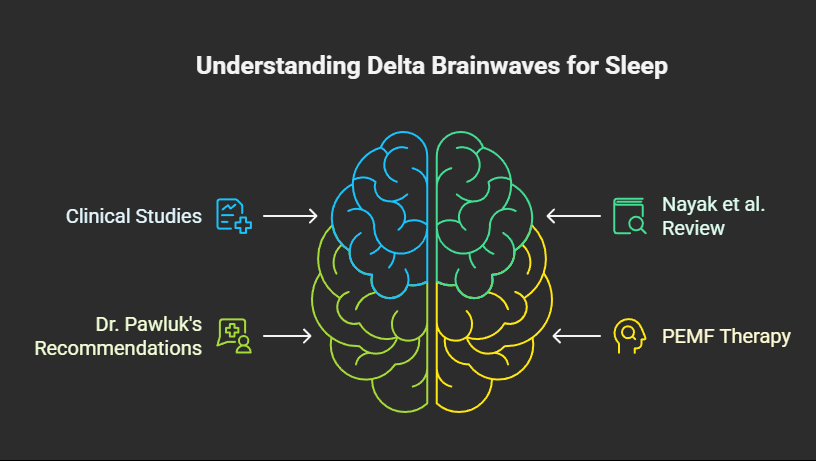
What is the Optimal PEMF Frequency for Deep Sleep?
Delta Brainwave Range: 0.5-4 Hz
The consensus from recent 2025 clinical studies is clear: the most effective PEMF frequency for promoting deep sleep falls within the Delta brainwave range, which is 0.5-4 Hz. This is the brain's natural frequency during the deepest, most restorative stages of sleep.
A comprehensive 2025 review by Nayak et al. identified the 1-4 Hz range as ideal for sleep-related applications, with stimulation near 3 Hz showing particular efficacy. This PEMF therapy helps to synchronize the brain's activity, guiding it into the slow-wave patterns that define deep sleep.
Further supporting this, Dr. William Pawluk, a leading authority on PEMF therapy, recommends frequencies at or below 5 Hz for sleep applications. His clinical experience suggests that a continuous 3 Hz stimulation throughout the night delivers optimal results for most individuals.
Understanding Sleep Stages and PEMF Frequencies
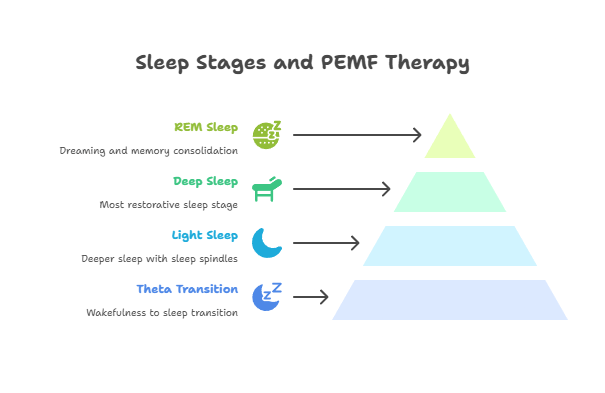
Light Sleep (N1)
4-8 Hz (Theta)
Transition from wakefulness to sleep. PEMF can help ease this transition.
Light Sleep (N2)
2-4 Hz (Delta)
Deeper light sleep with sleep spindles. PEMF helps maintain this stage.
Deep Sleep (N3)
0.5-2 Hz (Delta)
Most restorative sleep stage. Primary target for PEMF therapy.
REM
REM Sleep
4-8 Hz (Theta)
Dreaming and memory consolidation. PEMF supports healthy REM cycles.
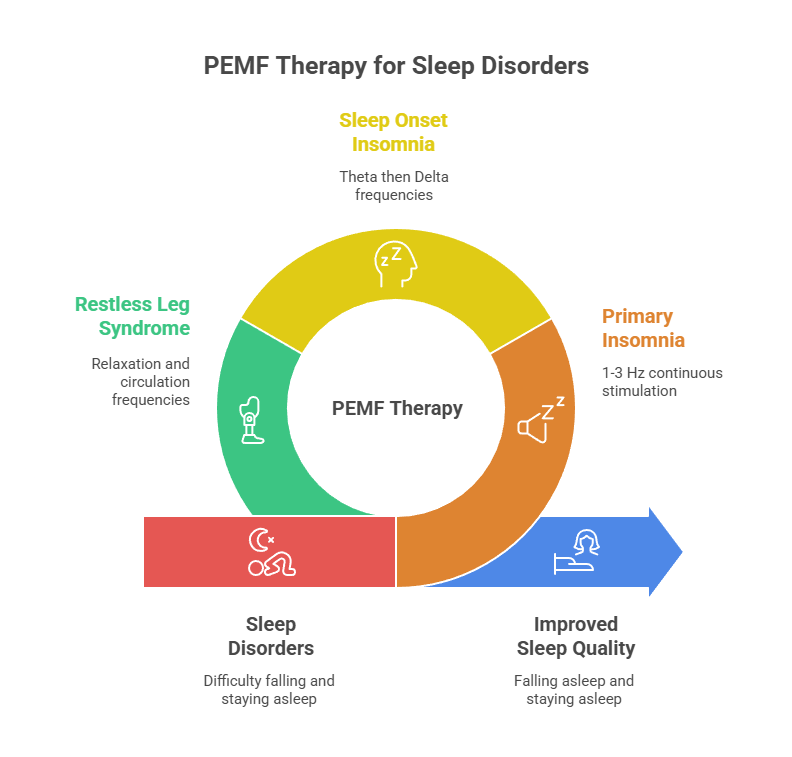
How Does PEMF Therapy Address Sleep Disorders?
PEMF therapy is not a one-size-fits-all solution; it can be tailored to address a variety of sleep disorders by using specific frequencies and protocols.
Primary Insomnia Protocol
Frequency: 1-3 Hz continuous throughout the night
This approach helps to both initiate and maintain sleep, preventing the frustrating cycle of waking up multiple times. The continuous low-frequency stimulation maintains delta brainwave activity.
Sleep Onset Insomnia Protocol
Initial Frequency: 4-7 Hz for 30-60 minutes before bed
Night Frequency: 1-3 Hz for remainder of night
For individuals who struggle specifically with falling asleep, this protocol starts with Theta frequencies to promote relaxation, then transitions to Delta frequencies for deep sleep.
Restless Leg Syndrome (RLS) Protocol
Relaxation: 1-15 Hz for symptom reduction
Circulation: 30-50 Hz to enhance leg circulation
A 2024 study outlined specific protocols for RLS, combining low frequencies for relaxation with medium frequencies to improve circulation and alleviate uncomfortable sensations.
What Do Experts Say About PEMF for Sleep Problems?
Dr. William Pawluk, MD - Leading PEMF Authority
"I recommend PEMF systems that can be run throughout the night. They should not be at any frequencies higher than 7 Hz (upper end of Theta), preferably 5 Hz (lower end of Theta) or below (Delta range)."
Dr. Pawluk emphasizes the importance of continuous stimulation, advising against devices that cycle through multiple frequencies, which he warns can disrupt sleep. His protocols often involve placing a PEMF coil near the head or neck to target the reticular activating system.
Clinical Research Consensus
The comprehensive 2025 review on PEMF for insomnia highlights the importance of session timing and duration, with most users benefiting from 20-60 minute sessions initiated about an hour before bedtime. This structured approach helps to synchronize the body's circadian rhythms.
Studies using a 7.83 Hz frequency, known as the Schumann resonance, have demonstrated significant improvements in sleep with minimal side effects. The consistent findings across multiple studies provide a strong foundation for PEMF therapy as a credible solution.
Are There Different PEMF Devices for Sleep?
Yes, the market for PEMF devices has expanded significantly by 2025, offering a range of options to suit different needs and budgets.
Full-Body PEMF Mats
Price Range: $349 - $2,500
The most common type of sleep device. These mats are designed to be placed on a bed and provide a gentle, low-frequency magnetic field throughout the night. The Align Zen Mat+ is one of the few devices specifically marketed for sleep, featuring automated looping sessions.
Portable Targeted Devices
Examples: Omnipemf NeoRhythm Pad
Smaller, targeted devices that offer app-controlled therapy and specific programs for sleep enhancement. These are a great entry point into PEMF therapy due to their lower cost and ease of use.
Medical-Grade Systems
Price Range: $4,000 - $19,000+
Found in clinical settings, these offer much higher intensity and more precise control. However, for sleep-related issues, research indicates that the lower intensities found in consumer-grade devices are both effective and ideal for safe, long-duration use.
What Does the Latest 2025 Research Say About PEMF for Insomnia?
Landmark 2025 Clinical Trial Results
A multicenter, randomized, double-blind, placebo-controlled trial involving 153 participants with insomnia has provided powerful evidence for the efficacy of PEMF therapy.
75%Treatment Group Response Rate41.6%Placebo Group Response Rate2.38Effect Size (Cohen's d)1 HzOptimal Frequency Used
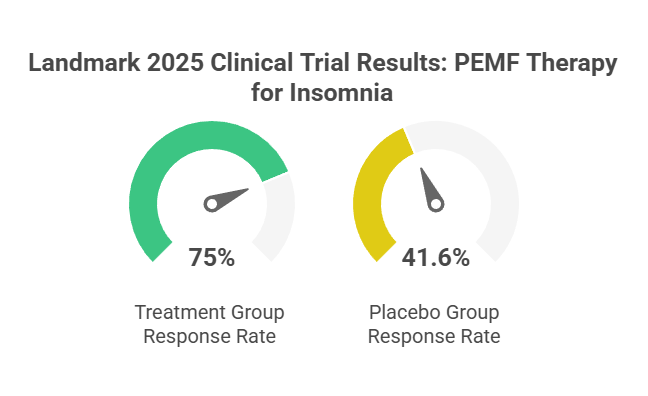
The research sheds light on the mechanisms behind PEMF's effectiveness. The therapy works through a process called brainwave entrainment, where the brain's electrical activity synchronizes with the external magnetic frequency. By using a 1 Hz frequency, which falls within the Delta brainwave range, the therapy effectively guides the brain into a state of deep, restorative sleep.
Furthermore, the study confirmed the excellent safety profile of PEMF therapy, with no significant adverse events reported. This is a crucial advantage over pharmaceutical sleep aids, which can have a range of undesirable side effects.
How to Use a PEMF Sleep Device for the Best Results
To achieve the best results with a PEMF sleep device, it is important to follow a consistent and structured routine.
Set Optimal Timing
Start your PEMF therapy session about 30-60 minutes before your intended bedtime. This allows your brain and body to wind down and prepare for sleep. Consistency is key - using the device every night helps to regulate your circadian rhythms and reinforces the brainwave entrainment process.
Select Delta Frequency Range
Set your device to the Delta range (0.5-4 Hz) for deep sleep, with 3 Hz being a commonly recommended starting point. The frequency setting should match your specific sleep goals - use lower frequencies (1-2 Hz) for deeper sleep or slightly higher (3-4 Hz) for general sleep improvement.
Position Device Correctly
For a full-body mat, simply lie down and relax. For smaller, targeted devices, placement is important. Dr. Pawluk suggests placing the applicator near the back of the neck or under the pillow to target the reticular activating system - the brain's arousal center.
Create Sleep Environment
Combine PEMF therapy with good sleep hygiene. Dim the lights, avoid screens, and ensure your bedroom is cool and quiet. The intensity should be set to a comfortable level - for sleep, a lower intensity is generally preferred for overnight use.
Maintain Consistency
Use the device every night for at least 2-4 weeks to experience the full benefits. Think of it as training your brain to recognize the PEMF signal as a cue for sleep. Over time, this consistency will lead to more profound and lasting improvements in your sleep quality.
Is It Safe to Use a PEMF Device Every Night?
Yes, for the vast majority of people, using a low-frequency, low-intensity PEMF device every night is considered safe. The magnetic fields used in consumer-grade sleep devices are gentle and have been the subject of extensive research.
Excellent Safety Profile
- FDA approved PEMF therapy for various applications since 1979
- 79% of users report no side effects in 2024 survey of 421 users
- Minor and temporary effects when they do occur (mild tingling, fatigue)
- No risk of dependency or withdrawal
- Non-invasive nature with extensive clinical evidence
!
Important Contraindications
PEMF therapy is not recommended for:
- Pregnant women
- People with pacemakers or implanted electronic devices
- Children and adolescents (still in growth phase)
- People with history of seizures (consult doctor)
- Those with active bleeding or serious medical conditions
Always consult with a healthcare professional before starting any new therapy.
Frequently Asked Questions
How long does it take for PEMF therapy to work for sleep? While some people report feeling more relaxed after the very first session, the benefits of PEMF therapy for sleep are typically cumulative. Most clinical studies show significant improvements after 2-4 weeks of consistent nightly use. The Fischer study, for example, noted the best results after 6 weeks of treatment. It is important to be patient and stick with the routine.
Can I use a PEMF device if I take sleep medication? It is essential to consult with your doctor before combining PEMF therapy with any medication. While PEMF is generally safe, your doctor can advise you on the best course of action and help you monitor your progress. In some clinical trials, participants were able to reduce their use of sleep medication after starting PEMF therapy, but this should always be done under medical supervision.
What is the difference between PEMF and a regular magnet? A regular, or static, magnet produces a constant magnetic field. PEMF devices, on the other hand, generate a pulsed electromagnetic field that varies in frequency and intensity. This pulsing action is what creates the therapeutic effect by stimulating cells and triggering biological processes. The dynamic nature of the magnetic fields in PEMF therapy is key to its effectiveness.
Will I feel anything during a PEMF session? Most people do not feel any physical sensation during a low-intensity PEMF session. Some users report a mild tingling or a feeling of warmth in the area being treated, but this is not common. The therapy works at a cellular level, and the magnetic fields are generally imperceptible.
Can PEMF therapy help with nightmares? By promoting deep, restorative sleep and regulating brainwave activity, PEMF therapy may help to reduce the frequency and intensity of nightmares. The Theta frequency range (4-8 Hz), which is associated with REM sleep and emotional processing, can be particularly beneficial. By improving overall sleep architecture, PEMF can contribute to a more peaceful night's sleep.
Conclusion: Your Next Steps to Better Sleep
As we have seen, the evidence supporting PEMF therapy for sleep is compelling and continues to grow. With strong clinical trial data from 2025, a clear understanding of the scientific mechanisms, and enthusiastic expert recommendations, PEMF has established itself as a powerful, safe, and non-invasive tool for improving sleep.
Key Takeaways
- Optimal frequencies: Delta (0.5-4 Hz) and Theta (4-8 Hz) ranges for sleep
- Clinical evidence: 75% response rate in rigorous 2025 clinical trials
- Expert consensus: Continuous overnight stimulation at 3-5 Hz recommended
- Safety profile: Excellent safety record with minimal side effects
- Device options: Consumer devices from $349-$2,500 available
- Timeline: Significant improvements typically seen after 2-4 weeks
Your journey to better sleep can begin today. The first step is to assess your individual needs and budget to determine which type of PEMF device is right for you. A full-body mat is an excellent choice for overall relaxation, while a portable device may be more convenient for travel.
Once you have selected a device, commit to a consistent nightly routine for at least four weeks to experience the full benefits. If you have any underlying health conditions, a consultation with a healthcare professional is a wise first step. With the right approach, PEMF therapy can be a life-changing investment in your health and well-being.
Expert Roundup
Leading Authorities on PEMF for Sleep
- Dr. William Pawluk, MD: "Continuous stimulation during the night with brainwave resonant frequencies (Theta and/or Delta brainwave patterns) is preferable."
- Nayak et al. (2025): "Low-frequency PEMF signals, particularly in the 1 to 4 Hz range, are considered ideal for sleep-related applications."
- Dr. Mohammed Enayat: Recommends 1-30Hz frequencies and 20-30 minute sessions for general wellness and sleep.
